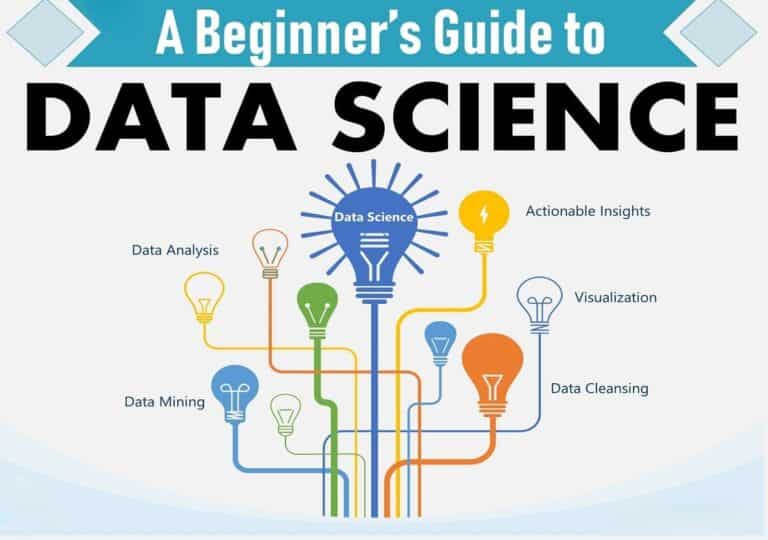Every moment, we generate data—whether we’re shopping online, using social media, or watching videos. This data holds valuable information, but it’s often unstructured and hard to understand. So, how do companies use this data to improve their services or make important decisions? The solution is Data Science. It’s a term you’ve probably come across in tech blogs, job listings, or everyday conversations. But what does it really involve? This beginner-friendly guide will walk you through the key ideas, tools, and importance of data science in a simple and clear way.
What is Data Science?
Data Science is the process of using data to solve problems, make decisions, and discover patterns. It combines a variety of skills and techniques from statistics, computer science, and domain knowledge to analyze information and extract useful knowledge.
Think of data science as a bridge between raw data and decision-making. It helps businesses understand customer behavior, improve products, optimize operations, and predict future trends.
Why is Data Science So Important Today?
We live in a world overflowing with data. Every click, every purchase, every sensor reading generates data. This massive amount of information is often called “Big Data.” But data, on its own, isn’t useful. It’s like having a library full of books but no one to read them and understand what’s inside.
Data science helps us:
- Make Better Decisions: Instead of guessing, businesses can use data to understand what customers want, where they should invest, and how to improve their operations.
- Predict the Future (to an extent!): Data science can help forecast sales, predict disease outbreaks, or even anticipate equipment failures, allowing for proactive action.
- Personalize Experiences: Think of recommended products on Amazon, personalized news feeds, or tailored advertisements. Data science makes these possible.
- Solve Complex Problems: From optimizing traffic flow in smart cities to discovering new drugs in healthcare, data science is tackling some of the world’s biggest challenges.
- Gain Competitive Advantage: Companies that effectively use data science can outperform their competitors by being smarter and more efficient.
In essence, data science turns raw data into a powerful asset, providing valuable insights that drive innovation and growth.
The Data Science Lifecycle: A Step-by-Step Journey
Becoming a data scientist isn’t just about knowing fancy algorithms. It’s about following a structured process. Here’s a simplified look at the typical steps involved in a data science project:
1. Problem Definition (Asking the Right Questions)
Before you even touch data, you need to understand what problem you’re trying to solve or what question you want to answer. This is crucial. A clear goal guides your entire process.
- Example: “Why are our customers leaving?” or “Which marketing campaign was most effective?”
2. Data Collection (Gathering Your Clues)
Once you know what you’re looking for, you gather the necessary data. This can come from many places:
- Databases: Stored information within a company (e.g., customer records, sales transactions).
- Web Scraping: Collecting data from websites.
- APIs (Application Programming Interfaces): Ways for different software to talk to each other and share data (e.g., social media data).
- Sensors: Data from devices like smartwatches, industrial sensors, or traffic cameras.
- Surveys: Information collected directly from people.
Data can be structured (like in spreadsheets, neatly organized) or unstructured (like text from emails, images, or videos).
3. Data Cleaning and Preparation (Wrangling the Wild Data)
This is often the most time-consuming part of data science, but it’s incredibly important. Real-world data is almost never perfect. It can be messy, incomplete, or have errors. This step involves:
- Handling Missing Values: Deciding what to do when data is missing (e.g., filling it in, removing rows).
- Removing Duplicates: Getting rid of identical entries.
- Correcting Errors: Fixing typos, inconsistencies, or incorrect data types.
- Transforming Data: Changing the format of data to make it suitable for analysis (e.g., converting dates, standardizing text).
- Feature Engineering: Creating new, more useful pieces of information from existing ones. For example, if you have birth dates, you might create an ‘age’ feature.
Think of it as preparing your ingredients before cooking – you wash, chop, and peel them to make sure they’re ready for the recipe.
4. Exploratory Data Analysis (EDA) (Getting to Know Your Data)
Now that your data is clean, you start exploring it to understand its characteristics. This involves:
- Summarizing Data: Calculating averages, medians, ranges, etc.
- Visualizing Data: Creating charts and graphs (like bar charts, line graphs, scatter plots) to spot patterns, trends, and outliers that numbers alone might not reveal. This is where data storytelling begins!
- Identifying Relationships: Looking for connections between different pieces of data.
EDA is like sketching a map before embarking on a journey – it helps you understand the landscape.
5. Modeling and Analysis (Building the Brain)
This is where you apply statistical methods and machine learning algorithms to answer your questions or make predictions.
- Statistical Analysis: Using mathematical techniques to find relationships, test hypotheses, and draw conclusions from data.
- Machine Learning (ML): Teaching computers to learn from data without being explicitly programmed. There are different types:
- Supervised Learning: You train the model with data that has “answers.”
- Classification: Predicting a category (e.g., “Is this email spam or not spam?”).
- Regression: Predicting a numerical value (e.g., “What will be the house price?”).
- Unsupervised Learning: The model finds patterns on its own in data without “answers.”
- Clustering: Grouping similar data points together (e.g., customer segmentation).
- Deep Learning: A more advanced form of machine learning, inspired by the human brain, used for complex tasks like image recognition and natural language processing.
- Supervised Learning: You train the model with data that has “answers.”
You’ll choose the right model based on your problem and the type of data you have.
6. Evaluation and Refinement (Is Your Model Good Enough?)
After building a model, you need to check if it’s accurate and performs well. You’ll use various metrics to evaluate its performance. If it’s not good enough, you go back, tweak your data preparation, try different models, or adjust their settings. This is an iterative process.
7. Communication and Deployment (Sharing Your Discoveries)
The best insights are useless if they can’t be understood and used. This step involves:
- Communicating Results: Presenting your findings clearly and concisely, often using compelling data visualizations, dashboards, and reports. Storytelling is key here to explain the “why” and “what next.”
- Deployment: If your model is designed to automate a task or provide ongoing predictions, you might deploy it into a system or application where it can be used in the real world.
Common Tools and Technologies Used in Data Science
Data scientists use various tools depending on their needs. Here are some popular ones:
- Programming Languages: Python and R are widely used due to their strong support for data analysis and machine learning.
- Data Visualization: Tools like Matplotlib, Seaborn, Tableau, and Power BI help create charts and graphs.
- Data Manipulation and Analysis: Libraries like Pandas and NumPy in Python make it easier to work with data.
- Machine Learning: Scikit-learn, TensorFlow, and Keras are popular libraries for building models.
- Databases: SQL is used for querying structured data. NoSQL databases like MongoDB handle unstructured data.
- Big Data Technologies: For handling very large datasets, Hadoop and Spark are common tools.
Types of Data Science Techniques
Depending on the goal, data science uses different techniques:
- Descriptive Analytics: What happened? Summarizes past data into meaningful information.
- Diagnostic Analytics: Why did it happen? Looks for causes and reasons behind trends.
- Predictive Analytics: What could happen? Uses historical data to forecast future events.
- Prescriptive Analytics: What should be done? Suggests possible courses of action based on predictions.
Applications of Data Science in Real Life
Healthcare
- Predicting diseases using patient data
- Medical image analysis (like X-rays and MRIs)
- Personalized treatment and drug discovery
Banking & Finance
- Fraud detection using transaction data
- Credit scoring and risk analysis
- Algorithmic trading and customer segmentation
Retail & E-Commerce
- Product recommendations (like Amazon & Flipkart)
- Customer behavior analysis
- Inventory and demand forecasting
Transportation
- Route optimization for delivery and ride-sharing apps (e.g., Uber)
- Traffic prediction and management
- Self-driving car algorithms
Entertainment & Media
- Personalized content suggestions (like Netflix & YouTube)
- Sentiment analysis on social media
- Audience targeting for ads
Education
- Predicting student performance
- Personalized learning experiences
- Improving course design with feedback data
Agriculture
- Crop yield prediction
- Weather forecasting for farming decisions
- Soil health and pest detection using sensors and data
Manufacturing
- Predictive maintenance of machinery
- Quality control using image recognition
- Supply chain optimization
Sports
- Performance analysis of players
- Injury prediction and prevention
- Game strategy and opponent analysis
Government & Smart Cities
- Crime prediction and prevention
- Waste and energy management
- Smart traffic and infrastructure planning
Conclusion
Data Science might seem difficult at first, but at its core, it’s all about understanding data to solve problems and make smarter decisions. By learning the basic parts of data science—like how to collect, clean, and analyze data—you can see how it affects almost every part of our daily lives, from the apps we use to how companies work.
Whether you want to start a career in this exciting field or just become more confident in using data, your journey can begin today. All it takes is curiosity and the drive to learn new things.
If you’re serious about starting, enrolling in a quality course can make a big difference. For example, many learners are choosing the Best Data Science Training in Noida to gain practical skills, expert guidance, and hands-on experience. A good training program will help you build a strong foundation and open doors to great job opportunities.
- Data Science Guide for Beginners | Learn Basics & Tips
- Discover the world of data science in this easy-to-understand, comprehensive guide designed especially for beginners in 2025. Learn what data science is, why it’s important, the key skills you need, and how to start your journey step-by-step. Whether you’re a student, professional, or just curious, this guide will help you unlock the power of data to make smarter decisions and build a successful career in today’s data-driven world.
- Best Data Science Training in Noida
Related posts:
 Engineering Design Assignment Help: Making Complex Projects Easier for Students
Engineering Design Assignment Help: Making Complex Projects Easier for Students
 Get Instant Last Minute Assignment Help in Australia by India Assignment Help
Get Instant Last Minute Assignment Help in Australia by India Assignment Help
 AI and Job Security: Discover Which Tech Roles Are Truly Safe in 2025
AI and Job Security: Discover Which Tech Roles Are Truly Safe in 2025
 How to Get Started with Web Development as a Beginner: Complete Guide
How to Get Started with Web Development as a Beginner: Complete Guide
 Powerful Legacy of Bhai Balwinder Singh Jatana: A Heroic Journey
Powerful Legacy of Bhai Balwinder Singh Jatana: A Heroic Journey
 CUET PG 2026: Your Complete Guide to the Central University Entrance Test for Postgraduate Programs
CUET PG 2026: Your Complete Guide to the Central University Entrance Test for Postgraduate Programs
 Master the Markets with Expert-Led Stock Market Classes Only at ICFM in Delhi and Online
Master the Markets with Expert-Led Stock Market Classes Only at ICFM in Delhi and Online







